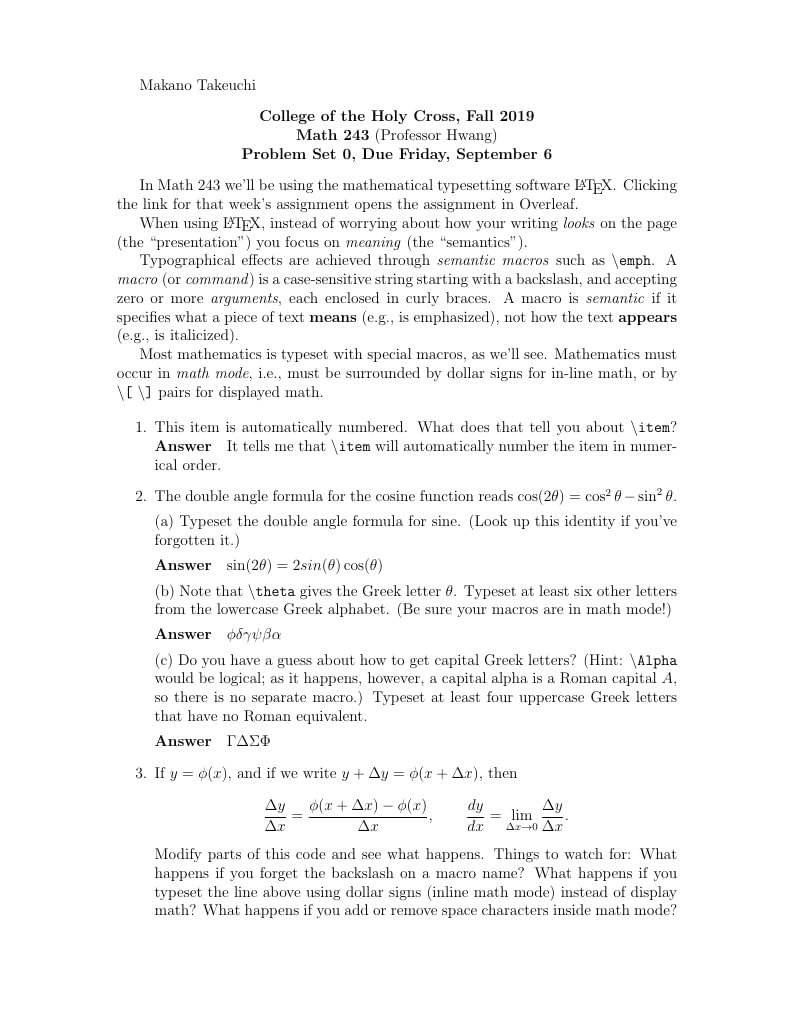
MATH243 problem set template
Author:
Makano Takeuchi
Last Updated:
6 anni fa
License:
Creative Commons CC BY 4.0
Abstract:
Problem set template with instructions

\begin
Discover why over 20 million people worldwide trust Overleaf with their work.
Problem set template with instructions

\begin
Discover why over 20 million people worldwide trust Overleaf with their work.
%%%%%%%%%%%%%%%%%%%%%%%%%%%%%%%%%%%%%%%%%%%%%%%%%%%%%%%%%%%%%%%
%
% Welcome to Overleaf --- just edit your LaTeX on the left,
% and we'll compile it for you on the right. If you open the
% 'Share' menu, you can invite other users to edit at the same
% time. See www.overleaf.com/learn for more info. Enjoy!
%
%%%%%%%%%%%%%%%%%%%%%%%%%%%%%%%%%%%%%%%%%%%%%%%%%%%%%%%%%%%%%%%
%%%%%%%%%%%%%%%%%%%%%%%%%%%%%%%%%%%%%%%%%%%%%%%%%%%%%%%%%%%%%%%%%%%%%%%%
%% Skip to the "\begin{document}" line below to see the visible text. %%
%% Compare the left and right-hand panes to compare what you type and %%
%% how it appears when typeset. %%
%% %%
%% ***** Type answers after the next line that looks like this ***** %%
%%%%%%%%%%%%%%%%%%%%%%%%%%%%%%%%%%%%%%%%%%%%%%%%%%%%%%%%%%%%%%%%%%%%%%%%
\documentclass[leqno,12pt]{article}
\usepackage{amsmath,amssymb}
\usepackage{graphicx}
\newcommand{\Term}{Fall 2019}
\newcommand{\Course}{Math 243}
\newcommand{\Assignment}{Problem Set 0}
\newcommand{\DueDate}{Friday, September~6}
\usepackage[body={6in,9in}]{geometry}
\newcommand{\brak}[1]{\left\langle #1\right\rangle}
\newcommand{\abs}[1]{\left\lvert #1\right\rvert}
\DeclareMathOperator{\lcm}{lcm}
\newcommand{\Neg}{\phantom{-}}
\renewcommand{\emptyset}{\varnothing}
\renewcommand{\subset}{\subseteq}
\newcommand{\ds}{\displaystyle}
%% Letter symbols
\newcommand{\Number}[1]{\mathbf{#1}}
\newcommand{\C}{\Number{C}}
\newcommand{\N}{\Number{N}}
\newcommand{\Q}{\Number{Q}}
\newcommand{\R}{\Number{R}}
\newcommand{\Z}{\Number{Z}}
\newcommand{\eps}{\varepsilon}
\newcommand{\Input}[1]{\includegraphics{#1.pdf}}
\newcommand{\Prob}[1]{\noindent\textbf{Question #1:}\quad}
\newcommand{\soln}[1][Answer]{\noindent\textbf{#1}\quad}
\newcommand{\Cmd}[1]{\textbackslash\texttt{#1}}
\pagestyle{empty}
\begin{document}
Makano Takeuchi
\begin{center}
\textbf{College of the Holy Cross, \Term} \\
\textbf{\Course} (Professor Hwang) \\
\textbf{\Assignment, Due \DueDate}
\end{center}
In \Course\ we'll be using the mathematical typesetting software
\LaTeX. Clicking the link for that week's assignment opens the
assignment in Overleaf.
When using \LaTeX, instead of worrying about how your writing
\emph{looks} on the page (the ``presentation'') you focus on
\emph{meaning} (the ``semantics'').
Typographical effects are achieved through \emph{semantic macros} such
as \Cmd{emph}. A \emph{macro} (or \emph{command}) is a case-sensitive
string starting with a backslash, and accepting zero or more
\emph{arguments}, each enclosed in curly braces. A macro is
\emph{semantic} if it specifies what a piece of text \textbf{means}
(e.g., is emphasized), not how the text \textbf{appears} (e.g., is
italicized).
Most mathematics is typeset with special macros, as we'll see.
Mathematics must occur in \emph{math mode}, i.e., must be surrounded
by dollar signs for in-line math, or by \Cmd{[}~\Cmd{]} pairs for
displayed math.
%%%%%%%%%%%%%%%%%%%%%%%%%%%%%%%%%%%%%%%%%%%%%%%%%%%%%%%%%%%%%%%%%%%%%%%%
%% ***** Type your answers after the "\soln" commands ***** %%
%%%%%%%%%%%%%%%%%%%%%%%%%%%%%%%%%%%%%%%%%%%%%%%%%%%%%%%%%%%%%%%%%%%%%%%%
\begin{enumerate}
\item This item is automatically numbered. What does that tell you
about \Cmd{item}?
\soln It tells me that \Cmd{item} will automatically number the item in numerical order.
\item The double angle formula for the cosine function reads
$\cos(2\theta) = \cos^{2}\theta - \sin^{2}\theta$.
(a) Typeset the double angle formula for sine. (Look up this
identity if you've forgotten it.)
\soln $\sin(2\theta) = 2sin(\theta)\cos(\theta)$
(b) Note that \Cmd{theta} gives the Greek letter~$\theta$. Typeset
at least six other letters from the lowercase Greek alphabet. (Be
sure your macros are in math mode!)
\soln $\phi\delta\gamma\psi\beta\alpha$
(c) Do you have a guess about how to get capital Greek letters?
(Hint: \Cmd{Alpha} would be logical; as it happens, however, a
capital alpha is a Roman capital~$A$, so there is no separate
macro.) Typeset at least four uppercase Greek letters that have no
Roman equivalent.
\soln $\Gamma\Delta\Sigma\Phi$
\item If $y = \phi(x)$, and if we write $y + \Delta y = \phi(x + \Delta x)$,
then
\[
\frac{\Delta y}{\Delta x} = \frac{\phi(x + \Delta x) - \phi(x)}{\Delta x},
\qquad
\frac{dy}{dx} = \lim_{\Delta x \to 0} \frac{\Delta y}{\Delta x}.
\]
Modify parts of this code and see what happens. Things to watch for:
What happens if you forget the backslash on a macro name? What
happens if you typeset the line above using dollar signs (inline
math mode) instead of display math? What happens if you add or
remove space characters inside math mode?
\soln If you do not include the backlash on a macro name, the Greek letter is spelled out in English instead of being written as a Greek symbol. If you use dollar signs instead of display math, it deletes the previously existing break in the text allotted to the equation. It appears as though nothing changes when you add or remove characters inside math mode.
\item If $a$, $b$, and~$c$ are non-zero numbers, and if
$ax^{2} + bx + c = 0$, typeset the (quadratic) formula for~$x$ in
terms of $a$,~$b$, and~$c$.
Hint: The macro \Cmd{pm} gives a plus-or-minus sign.\footnote{The
tilde character is a \emph{tie} or \emph{non-breaking
space}. Using ties is a little fussy, but helps distinguish
professional typography. Use a tie where a line break would
interrupt the reader's attention.}
\soln \[
x=\frac{-b\pm\sqrt{b^2-4ac}}{2a}
\]
\item One fundamental theorem of calculus asserts that if $f$~is a
continuous function on a closed, bounded interval $[a, b]$, then
\[
\frac{d}{dx} \int_{a}^{x} f(t)\, dt \qquad = f(x)
\quad\text{for all~$x$ with $a \leq x \leq b$.}
\]
(a) Modify parts of this code and see what happens. Hints:
\Cmd{,}~gives a thin space, \Cmd{quad} gives one em of space, the
width of the letter~m in the current font, \Cmd{qquad} gives two
ems. The underscore and caret each accept one argument, and make a
subscript or superscript. The \Cmd{text} command sets its argument
in ``paragraph mode''. Why is it needed here?
\soln Without \Cmd{text}, the words "for all x with..." all become once word and the computer reads it as part of the math equation instead of as English. It also allows for the break in the text.
(b) Evaluate the following derivatives and typeset the answers:
\[
\frac{d}{dx} \int_{0}^{x} e^{\sin t}\, dt;\qquad
\frac{d}{du} \int_{\pi}^{u} \log(1 + e^{t^{2}})\, dt;\qquad
\frac{d}{dt} \int_{-1}^{t} \frac{\sqrt{\tan s}}{1 + s^{2}}\, ds.
\]
\soln \[
e^{\sin x} \qquad \log(1+e^{u^{2}})\ \qquad \frac{\sqrt{tan t}}{1+t^{2}}\
\]
(c) Typeset the other fundamental theorem of calculus, sometimes
known as the \emph{evaluation theorem}. Don't forget to state
appropriate hypotheses.
\soln If \emph{f} is continuous at every point of [\emph{a,b}], and if \emph{F} is any anti derivative of \emph{f} on [\emph{a,b}], then
\[
\int_{a}^{b} f(x)\, dx = F(b)-F(a)
\]
\end{enumerate}
\end{document}